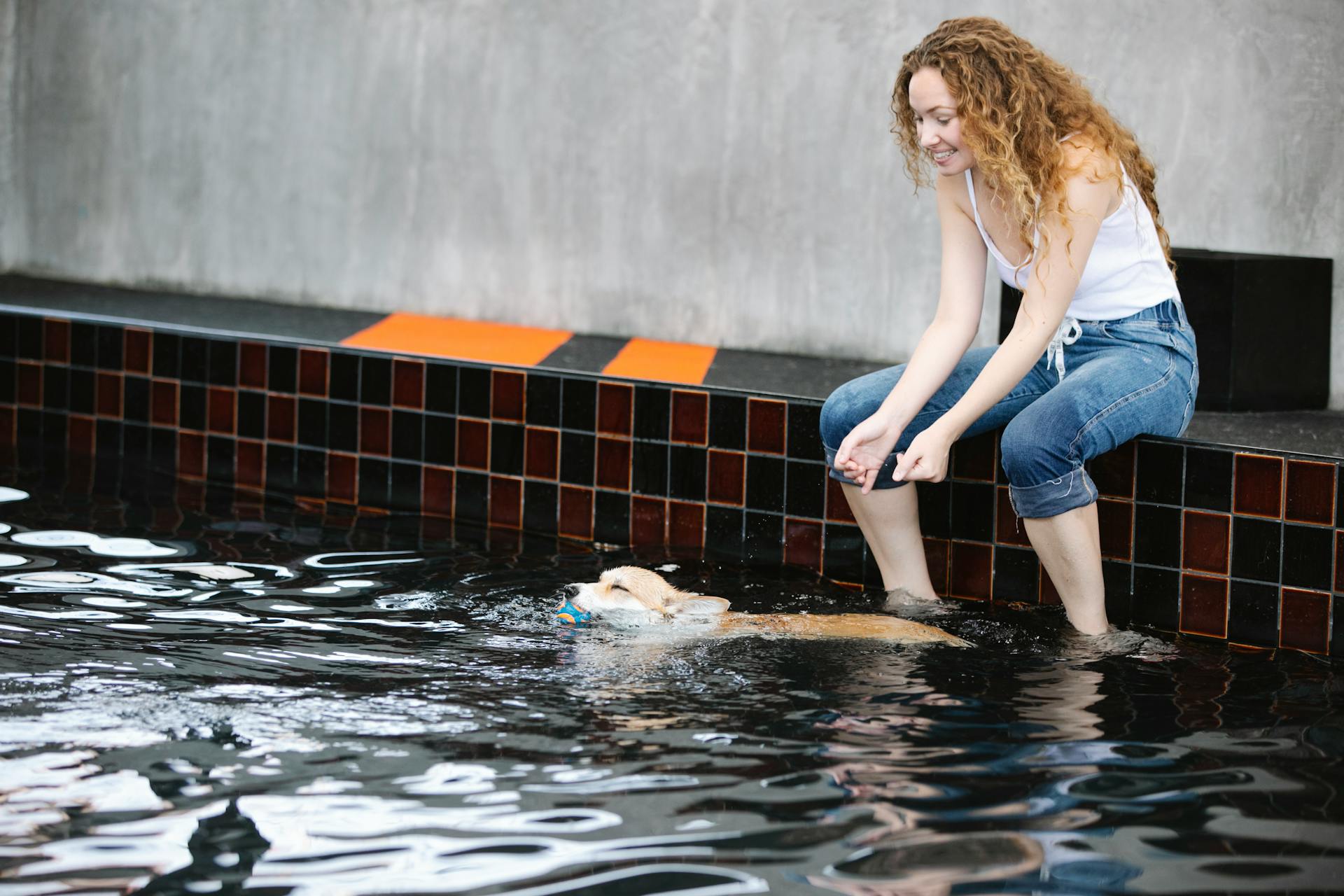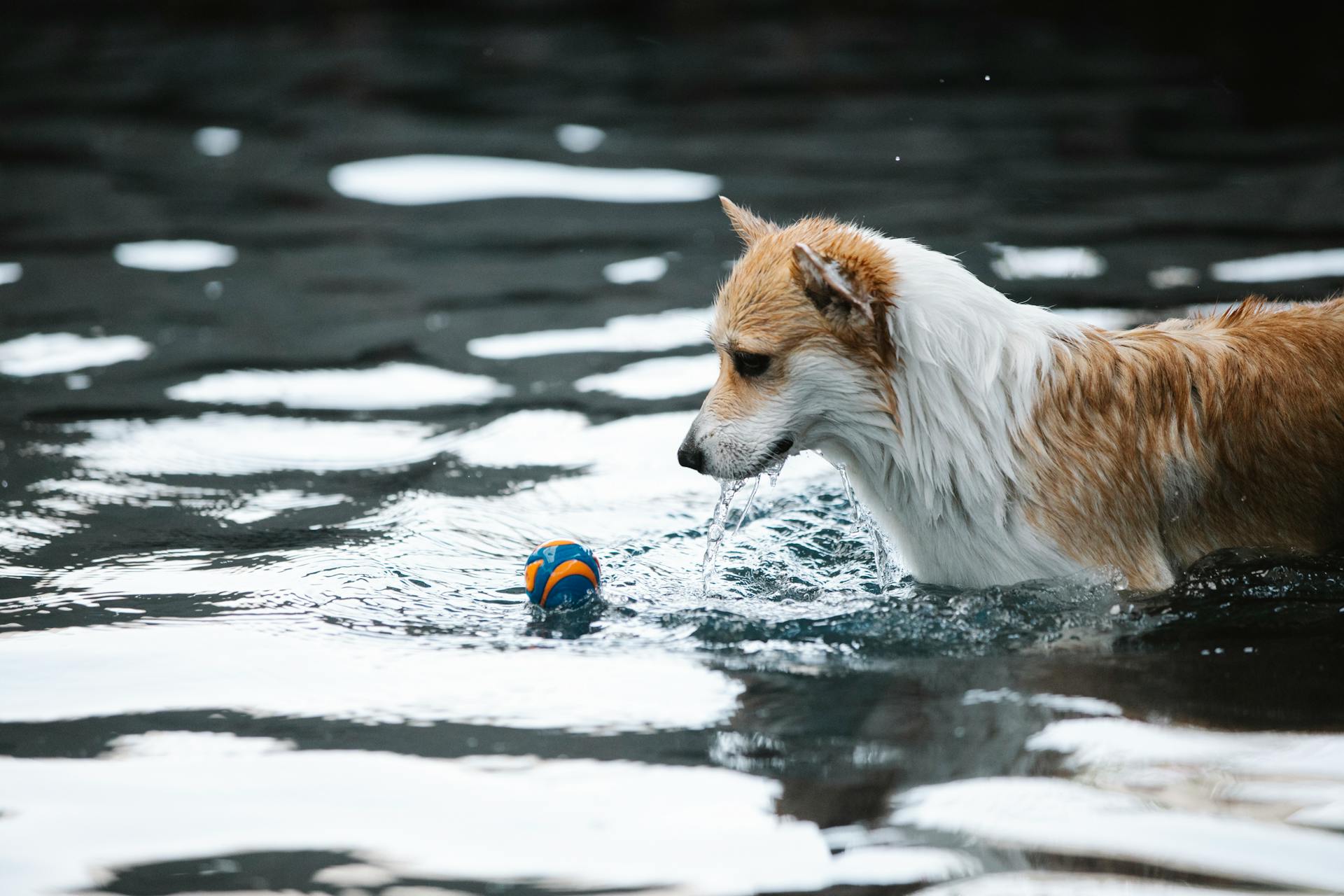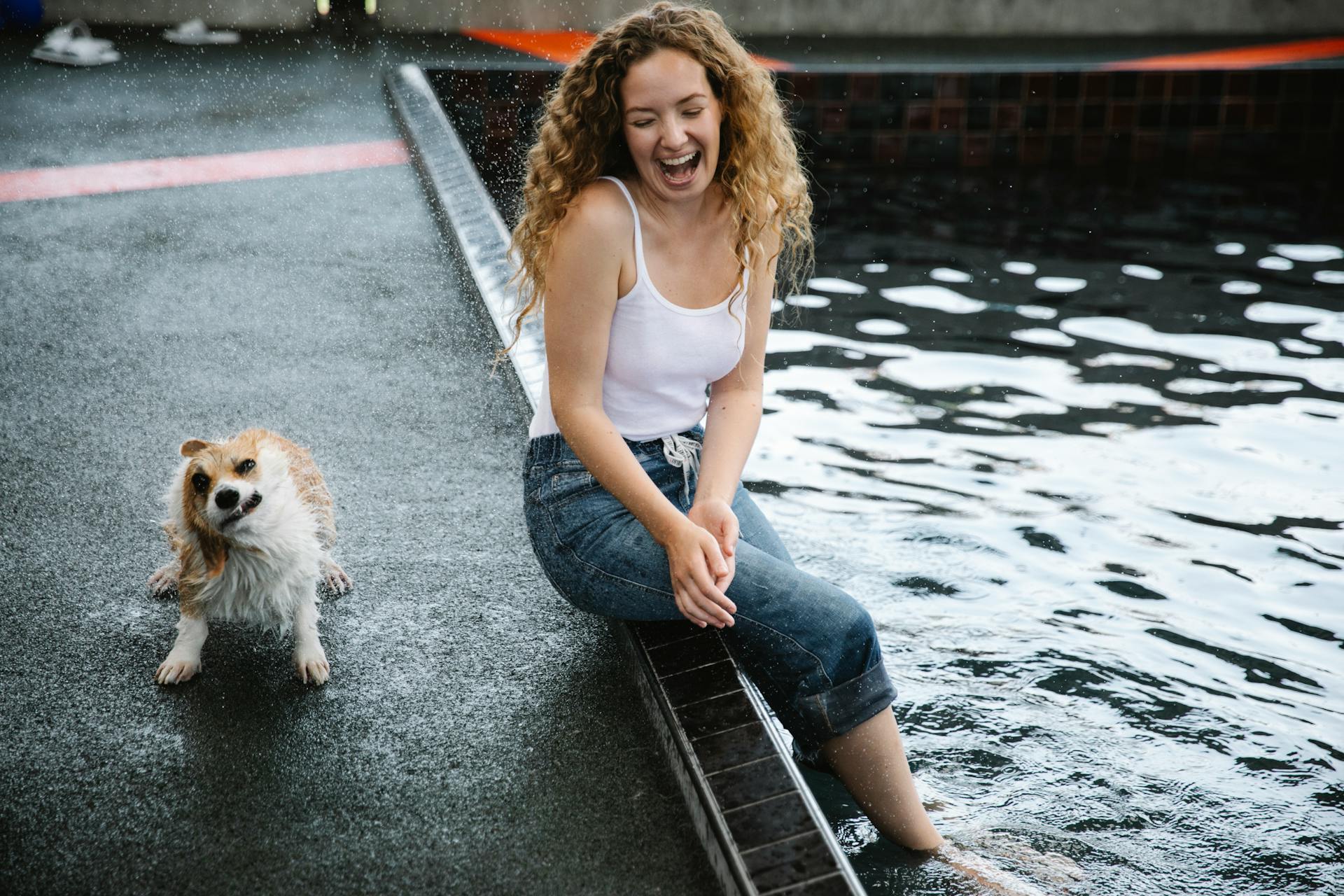
The Portuguese Water Dog is an ancient breed that originated in Portugal, where they worked alongside fishermen to herd fish and retrieve items from the water.
They are highly intelligent and active dogs that require regular exercise and mental stimulation to prevent boredom and destructive behavior.
Portuguese Water Dogs are known for their distinctive coat, which can be either curly or wavy, and requires regular grooming to prevent matting and tangling.
History and Origins
The Portuguese Water Dog has a rich history that spans centuries. They originated in Portugal, where they were bred to help guide fish into nets, retrieve things from the water, and carry items between ships.
Their ancestors may have come from Asia, specifically the steppes of Central Asia near the Chinese-Russian border, or they may have been brought to Portugal by the Berbers and Moors. Some theories suggest they were even brought by the Goths, a confederation of ancient German tribes.
The breed has been around for a long time, with the first historical account of a Portuguese Water Dog saving a man from drowning dating back to 1297. Despite their usefulness, the breed was nearly extinct by the early 1900s.
A wealthy Portuguese shipping magnate, Vasco Bensaude, sought to re-establish the breed in the early 20th century. He created a breeding program that led to the resurgence of the Portuguese Water Dog.
Today, the breed is recognized by the American Kennel Club and is a beloved companion for many families. Despite their long history, the Portuguese Water Dog is still a relatively rare breed, ranking 69th in popularity among the 155 breeds and varieties recognized by the AKC.
Breed Characteristics
The Portuguese Water Dog is a medium-sized breed, with males weighing between 42 and 60 pounds and females weighing between 35 and 50 pounds.
Their height varies as well, with males reaching up to 23 inches tall and females reaching up to 21 inches tall.
Portuguese Water Dogs have a unique coat that can be curly or wavy, and comes in a variety of colors including solid black, brown, or white, or black or brown with white patches.
Their eyes are typically black or dark brown, and their noses match the color of their coat.
This breed does not have an undercoat, which is a departure from some other water-loving dogs.
Portuguese Water Dogs are known for their friendly personalities and love kids and other dogs.
They are very open to change and new environments, and will be very engaged and focused on pleasing their owners no matter the environment.
They can be a little shy at first, but will warm up to strangers after a while.
Their exceptional willingness to please makes them easy to train, but they do require a lot of exercise due to their high energy levels.
They need some mental stimulation as well, or they might get into mischief if they get bored.
A different take: Shiba Inu $1
Temperament and Personality
Portuguese Water Dog puppies are highly territorial, which can manifest as barking at strangers or other dogs. They're naturally protective of their family and territory.
They're also extremely intelligent and can be strong-willed, making them a great companion for active families. With early socialization, they'll grow up to be well-rounded dogs.
Portuguese Water Dogs are high-energy dogs that require plenty of exercise and attention. They're naturally outgoing, curious, and friendly, making them a great addition to any family.
Their intelligence and enthusiasm can sometimes get the best of them, so it's essential to stay one step ahead and keep them engaged. With the right training and care, they'll thrive in any environment.
Portuguese Water Dogs are generally great with children, but it's crucial to supervise interactions between kids and pets. They can be rambunctious, so they may not be suitable for toddlers.
Early socialization is key to helping your Portuguese Water Dog become confident and comfortable around new people and situations.
Here's an interesting read: Why Are Labrador Retrievers so Popular
Care and Grooming
Taking care of your Portuguese Water Dog puppy's coat is a must. It's either medium in length and wavy, or short and curly, and needs to be brushed and combed at least twice a week to keep it free of tangles and mats.
To keep your puppy's coat looking its best, you'll need to trim it from time to time, depending on how fast it grows. The most common trim for a house dog is the "working retriever trim", with a shortened layer of hair covering the entire body.
In addition to coat care, regular nail trimming is a must. Pay attention to the webbing between your puppy's toes and take care not to injure that delicate skin.
Here are some essential grooming tasks to keep in mind:
- Brush your puppy's teeth with a dog-friendly toothpaste every day to prevent gum disease.
- Trim your puppy's nails regularly to prevent feet and leg issues later on in life.
- Wipe out and dry your puppy's ears thoroughly after swimming to prevent infections.
- Clip or trim your puppy's coat monthly to keep it looking neat.
Grooming & Care
Grooming your Portuguese Water Dog is an essential part of their care, and it's a great way to bond with your furry friend. They require regular brushing and combing to prevent tangles and mats, especially if you have a curly or wavy coat. Brush your Portie two or three times a week to keep their coat tangle-free.
Their coat needs to be trimmed from time to time, depending on how fast it grows. The most common trim is the "working retriever trim", where a shortened layer of hair covers their entire body. Alternatively, you can opt for the "Lion Trim", where their face and back half are shaved, with a tuft at the end of their tail.
Their nails need to be trimmed regularly to prevent feet and leg issues later on in life. Trim their nails once or twice a month, and if you can hear them clicking on the floor, they're too long. Short, neatly trimmed nails keep their feet in good condition and protect your shins from getting scratched.
Their ears need to be wiped out and dried thoroughly after swimming to prevent infections. Dental hygiene is also crucial, and you should brush their teeth at least two or three times a week to keep their breath fresh and prevent tartar buildup and periodontal disease.
Here's a quick rundown of their grooming needs:
By following these grooming tips, you'll be able to keep your Portuguese Water Dog looking and feeling their best. Remember to make grooming a positive experience filled with praise and rewards, and you'll lay the groundwork for easy veterinary exams and other handling when they're an adult.
Feeding
Feeding your Portuguese Water Dog is crucial to keeping them in top shape. A high-quality dog food is essential, and you should aim to feed your adult dog 2.5 to 3.5 cups daily, divided into two meals.
Dogs are individuals, just like people, and their food needs vary depending on their size, age, build, metabolism, and activity level. A highly active dog will need more food than a couch potato dog.
The quality of dog food you buy makes a big difference – better food will go further in nourishing your dog, and you'll need less of it. Keep your Portuguese Water Dog in good shape by measuring their food and feeding them twice a day.
If you're unsure if your dog is overweight, give them the eye test and the hands-on test. You should be able to see a waist, and with your hands on their back, you should be able to feel but not see their ribs without having to press hard.
On a similar theme: Do Dogs Need Water All Day
Health Concerns
As you're considering bringing a Portuguese Water Dog puppy into your family, it's essential to be aware of the potential health concerns that come with this breed.
Hip dysplasia is a common issue in Portuguese Water Dogs, causing pain and lameness in the rear legs. If left untreated, it can lead to arthritis later in life.
Gastric dilation/torsion, also known as bloat, is another potential health concern for this breed. It's a life-threatening condition that requires immediate veterinary attention.
Progressive retinal atrophy (PRA) is a degenerative eye disorder that can cause blindness. Fortunately, dogs can adapt to blindness, and a blind dog can live a happy and full life.
Spinal-cord problems can also affect Portuguese Water Dogs, causing a range of symptoms from mild discomfort to severe paralysis.
To ensure you're getting a healthy puppy, look for a reputable breeder who has had their dogs' eyes certified annually by a veterinary ophthalmologist. They should also have health clearances from the Orthopedic Foundation for Animals for hips, the Canine Eye Registry Foundation (CERF), and a DNA test for GM1 (storage disease).
Here are some key health concerns to be aware of in Portuguese Water Dogs:
- Hip dysplasia: a heritable condition that can lead to arthritis
- Progressive retinal atrophy (PRA): a degenerative eye disorder that can cause blindness
- Spinal-cord problems: can cause a range of symptoms from mild discomfort to severe paralysis
- Juvenile Dilated Cardiomyopathy: an inherited disease that can cause sudden death in puppies
- Storage Disease (GM1): a recessive genetic disorder that can be fatal to puppies produced by two carriers
Remember, every breeder should be willing to discuss the health history of their dogs and provide written documentation of their parents' health clearances.
Training and Exercise
Training a Portuguese Water Dog puppy requires a lot of attention and exercise. Socializing her to other people, dogs, and places outside the home is crucial for her development.
To enhance her ability and desire to accept obedience training, it's essential to exercise her for at least an hour a day, especially before any training session. This high-energy breed needs to stay active constantly, and exercise will help her focus during training.
To keep her engaged and prevent her mind from wandering, be assertive and demanding during each training session. Avoid letting her play or get distracted, and make sure she's looking at you while you teach commands. A deeper, more commanding tone of voice can also help her understand what you want her to do.
Readers also liked: How Much Exercise Do Labrador Retrievers Need
Getting Started in Sports

Getting started in dog sports can be a bit overwhelming, but it doesn't have to be. Here are some key things to consider.
You can start by learning about the basics of dog sports through an intro to dog sports. This will give you a good understanding of what's involved.
If you're new to dog sports, you may want to consider enrolling in a program with a mixed breed dog. Canine partners offer this option, and it's a great way to get started.
If you're not sure what titles and abbreviations mean in dog sports, don't worry - it's easy to learn. Just take a look at the titles and abbreviations section for more information.
So, which sport should you do with your dog? The answer depends on your dog's personality and your own preferences. Here are some options to consider:
To get started in dog training, you'll need to find a good instructor and a training program that suits your needs. You can also try virtual dog sports and events, which are a great way to get started from home.
7 Tips for Bringing Home a Healthy Puppy
Buy a puppy from a reputable breeder who has agreed to be bound by the Code of Ethics of the Portuguese Water Dog Club of America. This ensures you're supporting responsible breeding practices and getting a healthy puppy.
Start your search for a good breeder on the Web site of the Portuguese Water Dog Club of America, which maintains a referral list for breeders.
Ask your breeder to show you written documentation from the Orthopedic Foundation for Animals (OFA) clearing your puppy's parents of hip dysplasia. This is crucial for the breed.
Don't purchase a puppy from a breeder who can't provide written documentation that the parents were cleared of health problems that affect the breed. Any breeder who says their lines are free of all problems is either lying or knows nothing about Portuguese Water Dogs.
Take your puppy to your veterinarian soon after adoption to spot any visible problems and set up a preventive regimen to avoid health issues.
Having a good contract with the seller or shelter is essential, and in states with "puppy lemon laws", make sure you understand your rights and recourses.
For more insights, see: Pit Bulls in America
[Training]

Training is a crucial part of a dog's development, and it's essential to start early. Socializing a puppy to other people, other dogs, and various places outside her home has many benefits.
To enhance ability and desire to accept obedience training with ease and comfort, it's vital to exercise her for at least an hour a day, especially before any obedience training session. This breed requires a great deal of attention, and that's exactly what she gets during training.
Exercise should be done before obedience training to ensure she's focused and not too energetic. Her high energy level can be a challenge, but it's also an opportunity to provide her with the physical and mental stimulation she needs.
To keep her engaged and focused during training, it's essential to be assertive and demanding. This means not allowing her to play or let her mind wander while teaching the commands. Keep her looking at you and make the sound of your voice deeper than usual, with a demanding tone.
Worth a look: How Much Exercise Does a Bernese Mountain Dog Need

Here are some tips to keep in mind during training sessions:
- Exercise her for at least an hour a day before training.
- Be assertive and demanding during training sessions.
- Keep her looking at you and use a deeper, more demanding tone of voice.
Remember, consistency and patience are key when training your dog. With time and effort, she'll learn to accept obedience training with ease and comfort.
Exercise Needs
To build muscle, you need to engage in resistance training, which involves using weights, resistance bands, or your own body weight to challenge your muscles.
Aim for 2-3 sets of 8-12 repetitions for each exercise to stimulate muscle growth.
Resistance training can be done 2-3 times a week, with at least a day of rest in between to allow your muscles to recover.
Proper form and technique are crucial when performing exercises to avoid injury and get the most out of your workout.
Aerobic exercises, such as running or cycling, can be done 3-5 times a week to improve cardiovascular health.
High-intensity interval training (HIIT) is a type of aerobic exercise that involves short bursts of intense exercise followed by brief periods of rest.
To improve flexibility, include stretching exercises in your routine, aiming for 2-3 times a week.
Flexibility exercises should be held for 15-30 seconds to allow for maximum stretching.
Take a look at this: Muscled Bull Terrier
Frequently Asked Questions
How much should a Portuguese Water Dog cost?
A Portuguese Water Dog puppy typically costs between $1,500-$2,500, depending on factors like breeder reputation and location. Consider working with a responsible breeder or rescue organization to find your new furry companion.
Do Portuguese Water Dogs bark a lot?
Portuguese Water Dogs are generally quiet, but they do bark to alert their owners to people or animals arriving. They have a distinctive and loud bark, but with proper training, they can be well-behaved and relatively quiet.
Are Portuguese Water Dogs good service dogs?
Portuguese Water Dogs can be trained as therapy dogs, providing comfort and assistance to people in need. Their intelligence, trainability, and gentle nature make them a suitable breed for service work.
Sources
- https://vcahospitals.com/know-your-pet/portuguese-water-dog
- https://www.akc.org/dog-breeds/portuguese-water-dog/
- https://www.webmd.com/pets/dogs/what-to-know-about-portuguese-water-dogs
- https://dogtime.com/dog-breeds/portuguese-water-dog
- https://www.embracepetinsurance.com/dog-breeds/portuguese-water-dog
Featured Images: pexels.com


